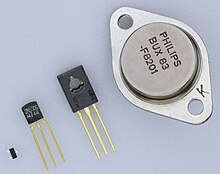TO-3
This article needs additional citations for verification. (October 2013) |

In electronics, TO-3 is a designation for a standardized metal semiconductor package used for power semiconductors, including transistors, silicon controlled rectifiers, and, integrated circuits. TO stands for "Transistor Outline" and relates to a series of technical drawings produced by JEDEC.[1]
The TO-3 case has a flat surface which can be attached to a heatsink, normally via a thermally conductive but electrically insulating washer. Its package usually have two leads, the case being the third connection, though devices with more leads are used. The TO-3 case has two mounting holes, with the centers spaced 1.186 inches (30.1 mm) apart.[2] The design originated at Motorola around 1955. The lead spacing was originally intended to allow plugging the device into a then-common tube socket.[3]
Typical applications

The metal package can be attached to a heat sink, making it suitable for devices dissipating several watts of heat. Thermal compound is used to improve heat transfer between the device case and the heat sink. Since the device case is one of the electrical connections, an insulator may be required to electrically isolate the component from the heatsink. Insulating washers may be made of mica or other materials with good thermal conductivity.
The case is used with high-power and high-current devices, on the order of a few tens of amperes current and up to a hundred watts of heat dissipation. The case surfaces are metal for good heat conductivity and durability. The metal-to-metal and metal-to-glass joints provide hermetic seals that protect the semiconductor from liquids and gases.
Compared with equivalent plastic packages, the TO-3 is more costly. The spacing and dimensions of the case leads make it unsuitable for higher frequency (radio frequency) devices.
Construction

The semiconductor die component is mounted on a raised platform on a metal plate with the metal can crimped on top of it, providing high heat conductivity and durability. The leads pass through the metal base plate and are sealed with glass. The metal case is connected to the internal device and the leads are connected to the die with bonding wires.
Common components that use the TO-3 package

Common voltage regulators:
Common transistors:
See also
- Chip carrier Chip packaging and package types list
- TO-18, a small metal package for low-power semiconductors
- TO-220 plastic case used for power semiconductors with similar ratings to TO-3 cases
References
- ^ "JEDEC TO-3 package specification" (PDF). JEDEC. Archived from the original (PDF) on June 18, 2017.
- ^ Mounting Considerations for TO-3 Package , page 3.
- ^ http://www.semiconductormuseum.com/Transistors/Motorola/Greenburg/Greenburg_Page5.htm
External links
- TO-3 standard from JEDEC
- TO-3 package from EESemi.com
- Hermetic packages from National Semiconductor
